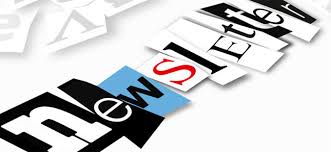3 Tips for Better Newsletter Subject Lines
 I could be wrong, but it seems to me that if you’re selling a professional service, you’re going to be most convincing when you “walk the talk,” modeling the behavior you claim to teach.
I could be wrong, but it seems to me that if you’re selling a professional service, you’re going to be most convincing when you “walk the talk,” modeling the behavior you claim to teach.
- If you’re a personal trainer, you should be in great shape.
- If you’re a financial planner, you should balance your checkbook.
- If you’re an E-Newsletter consultant, not only should you be good-looking, your E-Newsletter should stand as a prime example of what works best.
Which is why you’ll be happy to learn that after reviewing some of my past posts, I found that I pretty much follow my own advice.
Pretty much. Because I realized that there is one particular area in which I knowingly and willfully ignore my own suggestions: E-Newsletter Subject Lines.
As I’ll explain in a minute, when it comes to the subject line – the short phrase that is visible in the recipient’s in-box – there’s a best way to do these.
But I don’t follow this best way. Not because I don’t want the maximum number of people to open my newsletter, but because I can’t seem to stop myself from sacrificing effectiveness for the sake of coming up with a catchy title.
So I end up with things like “Singing in the Rain,” or “What a Difference a Difference Makes,” or “Hairy Party to You.” Clever? Maybe. But cryptic and lacking any real indication of what’s to be found within.
As a practical matter, that’s a problem. Our newsletter subscribers get lots and lots of e-mail; they’re constantly deciding what to open, what to save for (maybe) later and what to delete.
So when your E-Newsletter arrives in someone’s in-box, not only do you want them to recognize that it’s from you, you want them to put it in the “open now” category.
A good subject line – like a good headline on the front page of a newspaper or the outside of a magazine – entices people to read further.
Consider the following four, sample subject lines:
Company Newsletter
Tips for Improving Newsletters
5 Tips for Increasing Newsletter Open Rate
5 Mistakes That Will Kill Your Newsletter Open Rate
I think you’ll agree that the second is more compelling than the first, the third more than the second, and the fourth most of all (still with me?).
Three things that make it so (and that I recommend you use in crafting your own subject lines):
- Specificity. The first example doesn’t tell me anything other than who it’s from. Using this approach, the subject line of this issue, the next issue and every issue until the end of time will be exactly the same. Kind of like Stephen King calling his next book, My Next Book. Nothing here that makes you want to go further.
The second example is a little more specific (better), but the third and fourth are even more so, making them both more compelling. - Numbers. I don’t really know why this is, but apparently it’s been well tested that numbers in headlines – odd numbers in particular – are very effective in drawing people in.
Next time you’re in the supermarket check-out line, have a look at the magazines in the rack and note how many use numbers in the headlines on the outside cover. “7 Last Minute Lipstick Tips;” “5 Times U Shouldn’t Text Him;” “101 Things to Love About Middle-Aged Bald Men.” (Of course I just made that last one up; I can’t image there’s more than a few of dozen.) - Negatives. If I say “Here are some things you should do regarding X,” you might pay attention. But if I say instead, “Here are some things you should never do regarding X,” you’re even more likely to listen – you want to make sure you’re not already doing any of those things.
While I don’t suggest you do it every time, phrasing your subject line (or white paper or presentation, for that matter) as a warning is more likely to grab attention.
Here’s the bottom line. When it comes to creating an effective newsletter, I put subject lines somewhere in the middle of the list: not the most important thing, but certainly worth paying attention to. And whether you decide to follow in my playful footsteps or instead do something more deliberately strategic, it’s worth giving some thought to how you show up in your reader’s in-box.
Michael Katz is Founder and Chief Penguin of Blue Penguin Development. He specializes in helping (tiny) professional service firms talk about their work in a way that is clear and compelling. Sign up for his free newsletter, The Likeable Expert Gazette, here

 Delicious
Delicious Digg
Digg StumbleUpon
StumbleUpon Propeller
Propeller Reddit
Reddit Magnoliacom
Magnoliacom Newsvine
Newsvine
Comments
Post new comment